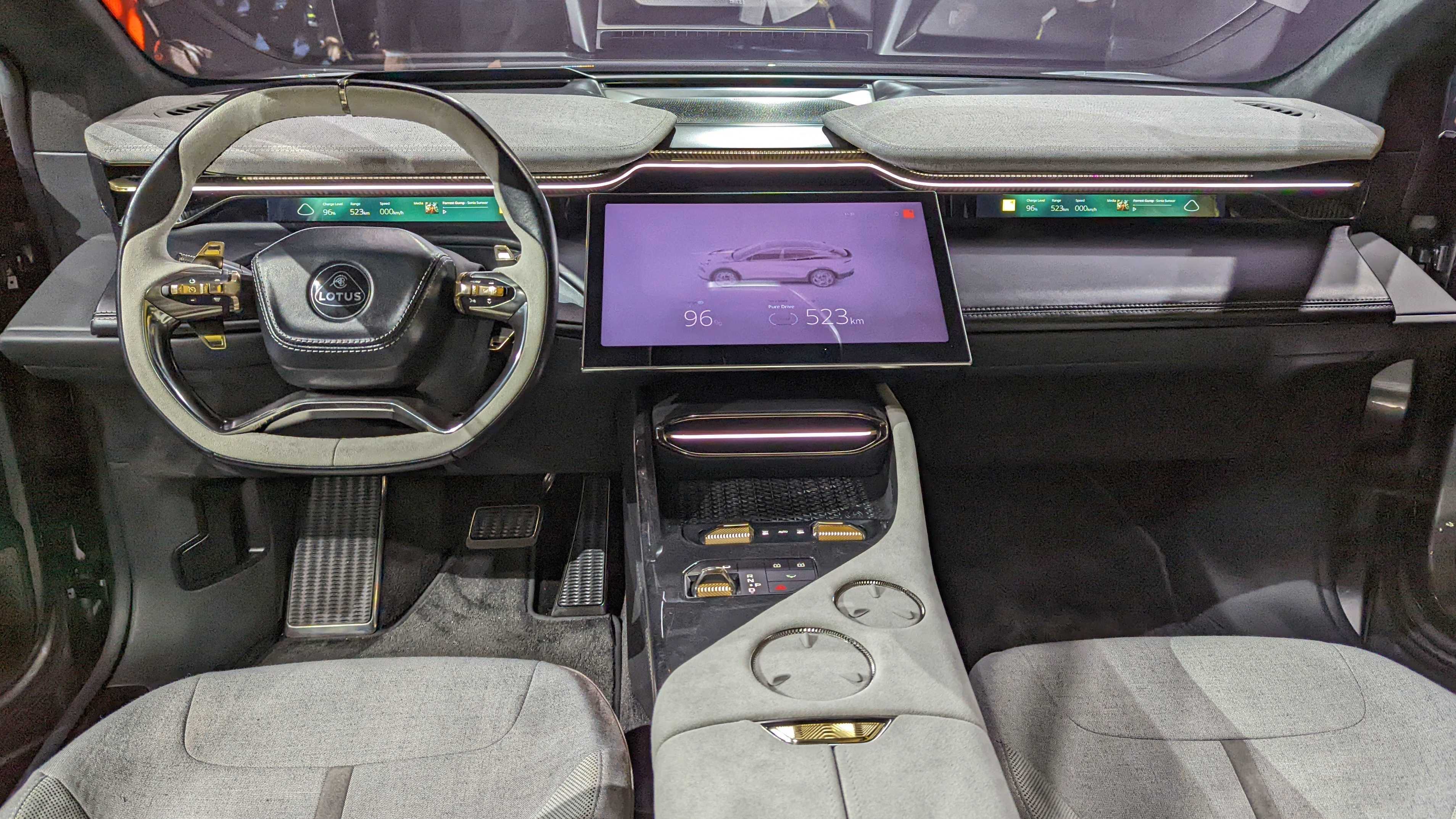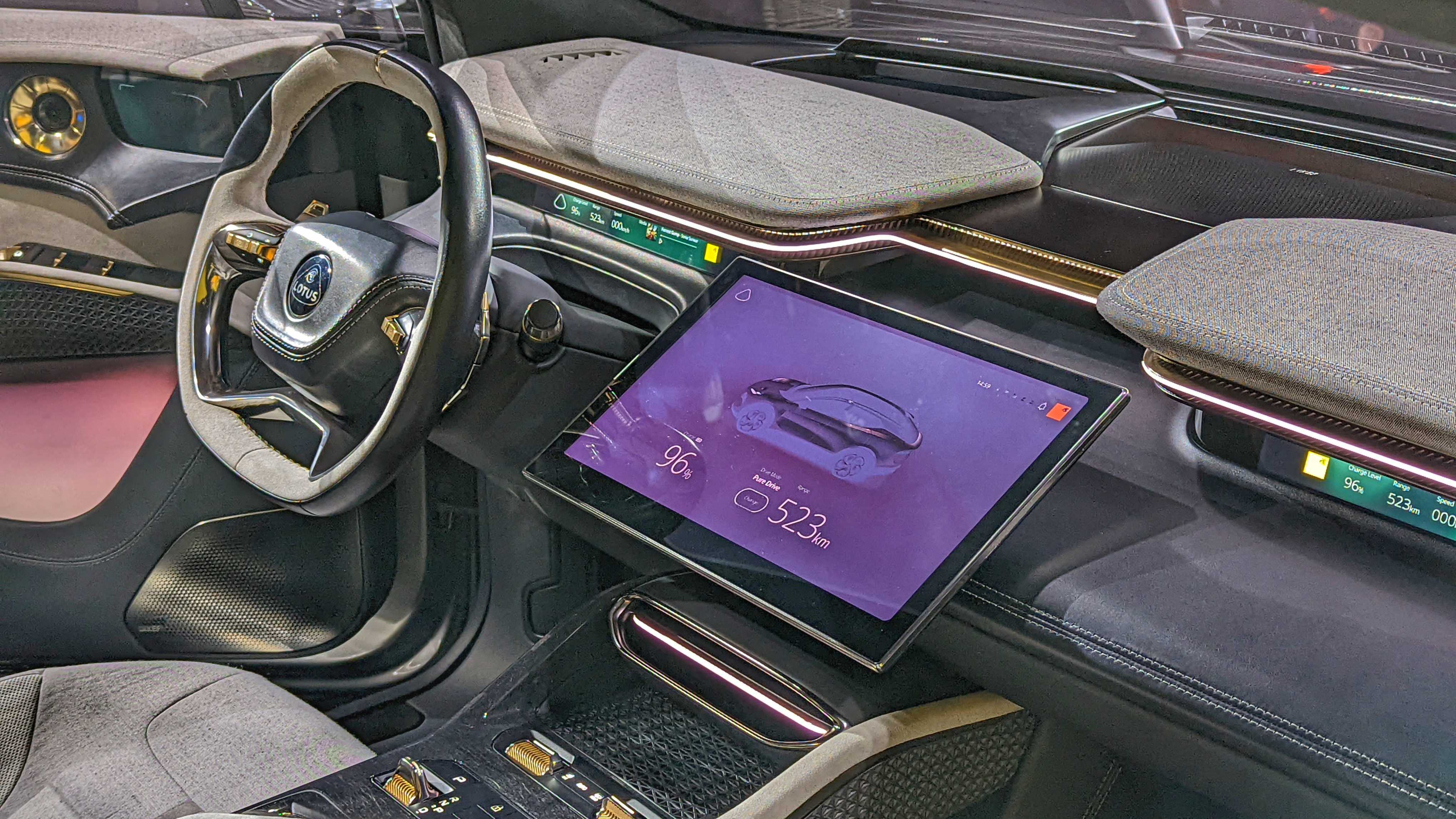The Lotus Eletre has some of the strangest displays we've seen in an EV
The Eletre's screens are an eclectic bunch

The fully electric Lotus Eletre has been officially unveiled. It's the British firm's first mass market electric car, and it boasts a striking design, a bunch of technology and perhaps the strangest display set-up we've seen in an EV to date.
Dubbed a 'hyper SUV' by Lotus, the Eletre boasts a 2.9 second 0-62mph time, 600hp of power delivering a top speed of 160 mph and a target of 373 miles WLTP of range. With support for 350kW charging, it can regain roughly 248 miles of charge in just 20 minutes.
The Eletre also boasts a world's first, with a deployable LiDAR (Light Detection and Ranging) system which sees pop-out components rise out of the bodywork, one above the windscreen, another above the rear screen and two more on each front wing of the electric vehicle.
This system will help deliver autonomous driving capability in the future (with update delivered over-the-air) - although no further information was provided on this during the exclusive Eletre launch event that TechRadar attended.
There's plenty more tech stuffed inside Lotus' first ever SUV, but as we clambered inside this sizable vehicle - it's no crossover like the Kia EV6 or Hyundai Ioniq 5 - what really struck us were the displays.
Move me, ever so slightly

Top speed: 160mph
0-62mph: 2.9 seconds
Power output: 600hp
Battery: 100kWh+
Charging: up to 350kW
Range: up to 373 miles
Release: 2023
Lotus has certainly not skimped on screens in the Eletre, with four displays in the cabin - and that's not even taking into account the two additional displays on the door panels which give you a live feed from the digital mirrors.
As is common these days, there's a large, 15.1-inch OLED touch screen which sits in the middle of dash - and it provides us with our first display oddity.
Sign up for breaking news, reviews, opinion, top tech deals, and more.
Over the years we've seen screens that rise out of the dash (including in a number of Audis), or rotate around to hide away (such as in the Bentley Continental GT) - but the Eletre does something different again here.
When the car is on, the display stands proudly, with a design that gives the illusion that it's floating.
However, it can also recline backwards onto the dash behind when not required, but the angle of movement is less than 90 degrees and it doesn't 'hide' or appear to protect the screen in any way.

On the plus side, the screen is still viewable in its reclined position from both driver and front passenger seats - it might just be more susceptible to glare in that position, so viewability could be hampered on the open road.
We also don't know how the whole interface will work, or even what it all looks like, as the car we sat in was only displaying the one image you can see in our photos.
Slender screens

Once you've got past the moving central display, there are two more screens up front that will catch your attention. Symmetrically, they're pleasing to the eye: both slender, horizontal panels that tuck neatly under the top of the dash.
On the driver's side, this slim (it's less than 30mm) yet readable display makes a lot of sense as the digital cluster, relaying important information such as speed, battery level and more. It's complimented by a HUD (head-up display) that projects similar pertinent information onto the windshield and into your line-of-sight.
So far, so good. Where things make a little less sense is over on the passenger's side. This isn't the first time we've seen a passenger focused display - we've seen them in a number of vehicles, including the Mercedes EQS, Porsche Taycan 4S and Honda e.
Lotus calls this the "ribbon of technology" and it's designed to show the occupant of the seat key information, with the ability to change what is displayed. It will be able to show things including music playback information, key driving stats and points of interest linked to mapping.
It's not currently clear how this screen, or the rest of the infotainment system in the Eletre will work. We'll have to wait for the car to land next year before learning more.
Rear seat passengers are not forgotten

The good times keep rolling in the back, as the fourth display in this infotainment quartet is exclusively for those in the rear passenger seats of the Eletre - and it's probably the most 'normal' of the lot.
Positioned on the fixed central armrest - the Lotus Eletre is a four-seater - the 9-inch touch display is angled up for easier use, with a wireless charging pad just behind it.
Details about this display are sparse at the moment, but we'd expect it to offer audio playback, the ability to display maps and points of interest, and potentially, function control for the seats, including heating, cooling and reclining.
Lotus has managed to come up with a unique infotainment setup in the Eletre, and if the interface is well thought out, with enough power to ensure everything runs smoothly, we could be looking at the start of a new generation of interior design for EVs; otherwise, it's just a flash in the pan.

TechRadar's former Global Managing Editor, John has been a technology journalist for more than a decade, and over the years has built up a vast knowledge of the tech industry. He’s interviewed CEOs from some of the world’s biggest tech firms, visited their HQs, and appeared on live TV and radio, including Sky News, BBC News, BBC World News, Al Jazeera, LBC, and BBC Radio 4.